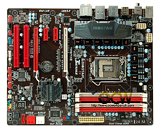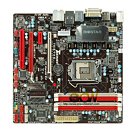Wednesday, September 29th 2010

Biostar's TSeries Release-Grade LGA1155 Motherboards Pictured
Biostar is ready with its pair of mid-range motherboards for the upcoming LGA1155 Sandy Bridge processor platform, based on the Intel P67/H67 Express chipsets. The two were earlier pictured in their pre-release forms at this year's Computex event. Both models fall into the company's mid-range TSeries family. The TSeries TP67XE is the larger (ATX) model that builds slightly over the chipset's feature set, it is outfitted with USB 3.0 and SATA 6 Gb/s (2 ports each). The rather high-end looking CPU VRM uses a total of 9 phases, power is drawn from two 8-pin ATX EPS connectors (probably connecting both connectors is optional, and only to enhance overclocking). Expansion slots include two each of PCI-Express 2.0 x16 (electrical x8/x8, when both are populated), PCI-Express x1, and PCI. Connectivity includes 8-channel HD audio, gigabit Ethernet, USB 3.0, FireWire, eSATA 3 Gb/s, and a number of USB 2.0 ports.
The second smaller (micro-ATX) board, the TSeries TH67XE, is based on the H67 chipset, and supports FDI that lets you use the integrated graphics processor on some processors. It uses a simpler 6+1 phase VRM, and goes slightly easy on the overclocking-capability department, but does retain USB 3.0 and SATA 6 Gb/s. Expansion slots include one PCI-Express 2.0 x16, one PCI-Express x16 (electrical x4), a PCI-Express x1, and a PCI. One out of six of the SATA 3 Gb/s channels from the PCH are assigned as an eSATA port. Other connectivity features include 8-channel HD audio, FireWire, gigabit Ethernet. Display connectivity includes DVI and D-Sub. Both boards will be out by the year's end, when Intel releases its new processor platform.
Source:
OCWorkbench
The second smaller (micro-ATX) board, the TSeries TH67XE, is based on the H67 chipset, and supports FDI that lets you use the integrated graphics processor on some processors. It uses a simpler 6+1 phase VRM, and goes slightly easy on the overclocking-capability department, but does retain USB 3.0 and SATA 6 Gb/s. Expansion slots include one PCI-Express 2.0 x16, one PCI-Express x16 (electrical x4), a PCI-Express x1, and a PCI. One out of six of the SATA 3 Gb/s channels from the PCH are assigned as an eSATA port. Other connectivity features include 8-channel HD audio, FireWire, gigabit Ethernet. Display connectivity includes DVI and D-Sub. Both boards will be out by the year's end, when Intel releases its new processor platform.


19 Comments on Biostar's TSeries Release-Grade LGA1155 Motherboards Pictured
- Only 5 internal SATA Ports
- One of the SATA ports isn't 90 degrees
- MOSFETs on RAM and SB are old design
- USB/Front Audio/Firewire headers don't look very high quality. Asus and Gigabyte put casing around them
- Solid caps, yes, but my Gigabyte X58A-US3R has like twice as many caps all over the board.
- BIOS chip looks reminiscent of those old chips you got in the Commodore Amiga.
- Pushpin mounting of heatsinks
- No PATA (I don't use it but there will be people out there still wanting legacy)
- CPU Socket has a very dull colour, obviously not made from quality materials
Need I say more?Sounds like Gigabyte and Asus ran out of shit to put plastic on.
Biostar T-Series boards are actually pretty solid and OC like hell.
And mine has 2 non 90 degree Sata ports.
Yes but i really do find asus's and gigabyte's casings around the headers to be annoying especially when you are working in a cramped interior.
ANd my Msi motherboard had more caps then my asus, but my asus overclocks much better.
Looks can be deceiving,
Pushpin mounting isn't the worse thing in the world and it does work.
Yes while you might want PATA support but that doesn't make it a junky motherboard.
Dull colors big deal thats a pretty bad way to judge the quality of the materials, My DSLR, my keyboard, and my tripod are all rather dull looking but they are make of cheap quality parts.
These looks like there will be good mid range boards but most things can't be known just from the looks and the spec, really reviews are needed but we will have to wait for some LGA1155 chips to come out first.
Really i have usually seen them as budget to mid range boards as they are often priced that way.
*edit*I thought they were mid to low end, i don't know really :laugh:
Actually it's an accurate way of telling what material the pins are made of. The cheaper the material, the worse the overclocks on the board will be.
They hold them in just as well as the plastic ones.
In the long run push pins are much much cheaper.
And the board is in the Mid range like all T series mobos.
Capacitors are there to clean the power and signal up. They smooth out peaks in the current and voltage and therefore will make the board operate more reliably. All the time. If your MSI wasn't a good overclocker compared to the Asus, it's obviously because the MSI had bad parts on it. Think about how bad it would have been if they didn't put the nicer components on it.
Nothing can deny these boards are cheap. I would rather pay a little more to get a low end Gigabyte board where they give you 2oz copper core, low RDS MOSFETs, ferrite core chokes and solid Japanese capacitors across their entire range, not just high end ones.
And cheap doesn't mean low quality.